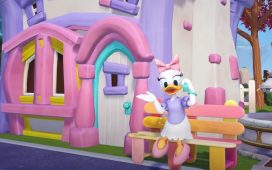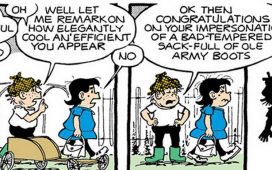There was a time, not so long ago, when it felt unlikely Nintendo would ever enter the world of VR. As Oculus, Vive and PlayStation VR were all making their initial plays, Nintendo was finding success with a very different bit of kit; a hybrid device that promised the possibility of play anywhere, was built around very traditional video games and sold on the idea of its inherent sociability. It always seemed one of those cute ironies that, while everyone was obsessed with these technologies that asked you to shut yourself away from the world, Nintendo stole a march by offering a console that said you’re free to go out and enjoy it.
There now is the prospect of Nintendo VR, though – a tantalisingly close one, too, seeing as it’s out early next month – and, typically and somewhat unsurprisingly, it’s quite unlike any VR already out there. This is Nintendo marching to its own beat once again; lo-fi, imaginative and with a suite of creative flourishes, Labo VR is everything I’d personally hoped for from Nintendo’s first foray into VR since Gunpei Yokoi’s ill-fated Virtual Boy.
It helps that it’s tied to one of the more offbeat inventions to have come out of Nintendo in recent years (and something which itself feels blessed by the toymaker touch of old-school Yokoi). Labo VR, as the name suggests, is just as much the latest in DIY cardboard construction sets as it is a means for VR, with the first thing you do upon opening up the box being building those goggles yourself. It’s a fairly involved, meticulously explained process that should take most people around 20-25 minutes, the end result a sturdy and moderately light headset.
This isn’t the first headset like this, of course – Google Cardboard even had the audacity to use the exact same materials – but there are some key points of differentiation here. The first is that you don’t affix the headset to your face, but rather hold it up to your eyes. There’s no headband, and so you must always have a hand on the device to keep it in place. A backwards step? Maybe, but Nintendo’s playing a different game here – this is something you’re supposed to dip in and out of rather than sit down with for prolonged periods, and in doing that Nintendo has been able to secure a 7+ age rating that makes it the ideal entry point for the younger market it’s courting with Labo.
And as counterintuitive as a device aimed at providing immersion that goes out of its way to frequently break immersion sounds, it works. There are soft stickers applied to the nose piece to make sure all that rough cardboard doesn’t scratch at your nose, while double tapping the top corner of the headset serves as an input that allows you to back out of games or navigate menus. The Switch itself slots neatly into place, with a safety guard provided (modelled out of cardboard, of course) to ensure that it does’t fly out of place if things get too intense.
The Switch itself provides another point of contention. It is, of course, loaded up with all sorts of gyros and gadgets that provide the motion tracking VR requires, but its screen is a paltry 720p – nearly half the resolution you’d expect of the smartphones that offer similar lo-fi VR experiences. It should look terrible, but somehow it does not. This isn’t the measure of the latest Oculus or Vive headsets by some measure, and you can certainly count the individual pixels before your eyes, but through some magic – maybe it’s slightly out of focus optics helping soothe away any incriminating sharpness, or Nintendo finally embracing anti-aliasing for a smoother image quality – it goes beyond being serviceable and feels like a more than adequate VR solution.
Image quality is half the battle, and Nintendo’s big investment – and Labo VR’s most delightful innovations – come through the control methods. There are toy-free games – even VR-free ones, though let’s get to that later – though the real magic comes when VR is interacting with one of the strange mechanisms enabled by Labo. The starter kit comes with the blaster, some distant cousin of the Super Scope that’s conjured out of cardboard and rubber bands. It’s a sturdy thing, with a few surprises such as the recoil provided by bands within the device, as well as the satisfying thunkthunk of reloading.
The main game it’s built around is a simple on-rails shooter (literal rails in the first level, as you ride on a rollercoaster and shoot a variety of Splatoon-esque creatures), enlivened by a couple of neat mechanics such as the ability to pause time and fire off a series of shots that then burst into life when time is resumed. There’s a turn-based game that involves hoovering up fruits and then feeding them to hungry hippos, with two players passing the device from one to another as they compete for score – one that’s fairly hard to parse, but one that’s full of character.
There are other experiences, enabled by other toys available in the full kit (our own experiences were limited to the basic headset and blaster that’s available in the starter kit). A camera is used for a gentle exploration game where you’re snapping wildlife (and also a Pokmon Snap tie-in is only a matter of time), while looking up a cardboard duck’s behind lets you play a flying game. The duck is used in tandem with a ‘wind pedal’ that’s also used for another game where you play a leaping frog – in both cases, stepping down on the pedal blasts a gust of air in your face which feeds into the sensation of flying. It’s an eccentric, absolutely excellent touch, and just the kind of thing I’d have hoped for when Nintendo made its return to VR.
Finally, there’s an elephant mask that doubles up as a 3D painting tool, the trunk being used as an arm that extends out with a tilt brush at its end. It promises a certain amount of creativity that can be unleashed by Labo VR, and it all feels like something of a trojan horse for the most exciting part of the whole package; a whole new game creator, dubbed Toy-Con Garage VR, that massively opens up the potential for making games within Labo.
This is a full 3D editor that offers object placement and in-depth logic tools that offer up all sorts of complexity and possibilities, with some of those possibilities suggested at in the 64 games that come as part of the Labo VR package. They’re not all necessarily VR games, and are templates that can be used and tinkered with for your own experiments, with a further 64 slots available for whatever you create.
And where from there? The obvious next step is bringing VR to existing Nintendo Switch games – how dearly I’d love to be able to look out across Hyrule from atop one of Breath of the Wild’s heights – which seems like a given, even if there are no explicit announcements being made just yet. For now, we have Nintendo’s first experiments with VR for a few generations, and one that may well frustrate as many as it delights with its alternate, lo-tech take. You can’t deny, though, that it’s pure Nintendo in its approach.














